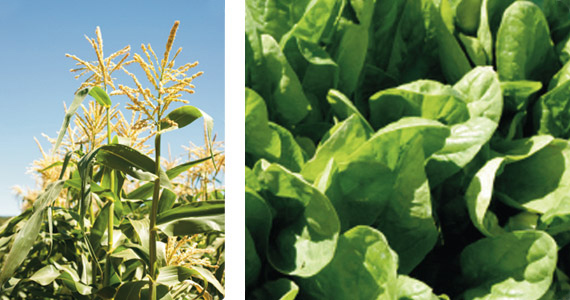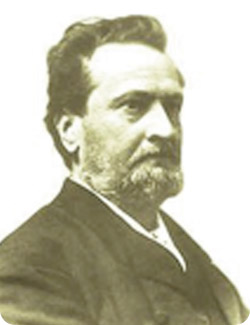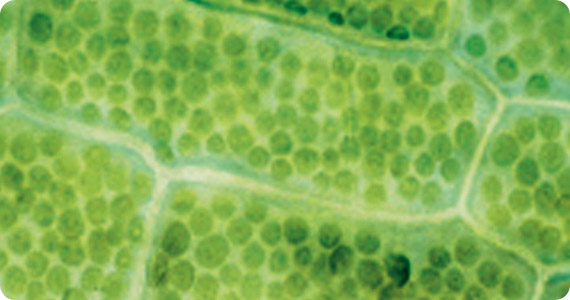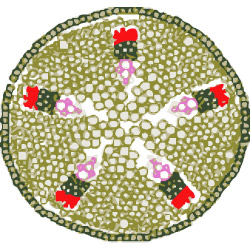Florigen, the flowering hormone
Many plants are ‘short-day’ plants, which means that the plant starts to bloom once the days shorten. This is why horticulturists cut the amount of light from eighteen hours a day to twelve when they want to start the flowering phase. It’s actually a shame from the plant’s perspective: six fewer hours of light a day is six fewer hours of photosynthesis, and thus less energy for your plants in the form of sugars. Yet there’s also a substance that can get your plants blooming without your having to cut down on their light.
D. Kroeze, CANNA Research
What really happens when the days get shorter or when you cut back to 12 hours a day? When the light goes down to 12 hours or less, the leaves start to manufacture a substance that triggers flowering, which gets transported to all over the plant. This substance is called florigen or flowering hormone.
The term ‘short-day plant’ isn’t completely accurate. It’s not the fact that the days are getting shorter that makes the plant decide to flower, but that the nights are getting longer. Although the difference may seem trivial, it does explain why a night-time visit to your growing space will delay flowering for your plants. When you turn on the light, the plant’s night is over; it has now become too short to stimulate flowering. The plant has to start over counting the hours of darkness from zero.

Maize plants Spinach crops Differences in daylight
Other short-day plants include maize (left), chrysanthemum and chicory. There are also long-day and day-neutral plants. Examples of long-day plants are spinach (right), lettuce and barley. One day-neutral plant is tobacco.
The discovery of florigen
 In 1865 a German scientist named Julius von Sachs discovered that when he transferred sap from a flowering plant to a non-flowering plant, the non-flowering plant started to flower as well. This even happened when the two plants were from different species. However, no matter what he tried, he never succeeded in isolating the substance responsible for flowering.
In 1865 a German scientist named Julius von Sachs discovered that when he transferred sap from a flowering plant to a non-flowering plant, the non-flowering plant started to flower as well. This even happened when the two plants were from different species. However, no matter what he tried, he never succeeded in isolating the substance responsible for flowering.
Many people after him have tried in vain to isolate florigen, which made it into something of a mystery. It got to a point where the question was not only what the substance actually was, but whether it even existed – at least until a few years ago. Now, one of the greatest mysteries of plant biology seems to have been solved.
Julius von Sachs (pictured top-left) made other major discoveries besides the existence of florigen. For example, he discovered chloroplasts and the fact that they produce sugar. He also discovered that glucose is stored in the form of starch in granules. In other words, the mystery of florigen was just as old as much of the fundamental knowledge in plant biology.

Chloroplasts
Why it took so long to find florigen
During the quest for florigen, it became clear that the sap flowing through the phloem (vessels) of the plant contained more than water and the sugars produced by photosynthesis in the leaves. As it turned out, many semiochemicals (substances that send signals to the plant) are dissolved in the phloem sap. These are mostly small molecules in very low concentrations. The phloem transports information from one place in the plant to another, including the signal to flower, in the form of these substances. This is why the phloem is also known as ‘the information superhighway’.
Actually, florigen had been found a few years earlier, but its function had not been discovered until recently. You may wonder why it took so long to find florigen. Here’s the reason: once the night length has crossed a certain threshold, the leaves produce a signal to start manufacturing florigen. The substance is only made in the growing points of the plant; a different substance, which reacts with the substance from the leaves, occurs only in the cells of growing points. The two substances together are actually the real florigen.
In addition, but no less important, is the fact that these are very tiny molecules, which were only discovered in the last few years. Until then, laboratory equipment was simply not advanced enough.

The phloem (red) is the living vascular tissue of the plant, through which mainly sugars and water are transported. Besides the phloem there is also xylem (pink), dead tissue that transports nutrients and water up from the roots.
The future is smiling?
After more than 140 years, the quest for florigen is finally over. A great mystery has been solved. This is fine for science, but what does it mean for your average person? The answer is easy: a lot! Manipulating florigen has enormous potential. Its discovery will bring about a revolution, in particular for conventional agriculture. Greenhouse horticulture will see increased yields from more hours of light. However, scientists are especially thinking about growing crops in places where it was previously impossible, such as growing some tropical crops in Northern Europe. But a lot may change for tropical regions too. The shortened growth time will mean that more crops can be grown in one growing season than is possible now.
Besides this immediate effect on food production, there will also be a revolution for seed companies. For example, fruit trees could be made to flower in the first year and so can be crossed with each other within months instead of the usual years breeders spend waiting for the first flowers. For hobbyists, it will of course be the higher yields that make the applications of florigen most interesting.
We should not get carried away. It will be many years before we can make practical use of florigen. However, one thing is certain, its discovery will change agriculture and plant breeding forever.
Florigen and genetic modification
Why the question mark after ‘the future is smiling?’ Because florigen can’t simply be added to a plant. Biotechnology companies such as Monsanto will have to provide crops with the information they need to make florigen themselves independent of day length, using genetic modification. Since this gene will initially be put into one or two crop varieties, these few varieties will quickly drive out local varieties (genetic erosion).
This will mainly be a problem for developing countries where agricultural production is now less than optimum, and where these new crops could greatly improve food production. At first, these monocultures of just a few varieties on such a huge scale will produce lots of food, but in the long term will lead to enormous problems from diseases. And what are you going to eat when the food crops are gone? That’s the next challenge!
------------
source: http://www.canna-uk.com/florigen
Many plants are ‘short-day’ plants, which means that the plant starts to bloom once the days shorten. This is why horticulturists cut the amount of light from eighteen hours a day to twelve when they want to start the flowering phase. It’s actually a shame from the plant’s perspective: six fewer hours of light a day is six fewer hours of photosynthesis, and thus less energy for your plants in the form of sugars. Yet there’s also a substance that can get your plants blooming without your having to cut down on their light.
D. Kroeze, CANNA Research
What really happens when the days get shorter or when you cut back to 12 hours a day? When the light goes down to 12 hours or less, the leaves start to manufacture a substance that triggers flowering, which gets transported to all over the plant. This substance is called florigen or flowering hormone.
The term ‘short-day plant’ isn’t completely accurate. It’s not the fact that the days are getting shorter that makes the plant decide to flower, but that the nights are getting longer. Although the difference may seem trivial, it does explain why a night-time visit to your growing space will delay flowering for your plants. When you turn on the light, the plant’s night is over; it has now become too short to stimulate flowering. The plant has to start over counting the hours of darkness from zero.

Maize plants Spinach crops Differences in daylight
Other short-day plants include maize (left), chrysanthemum and chicory. There are also long-day and day-neutral plants. Examples of long-day plants are spinach (right), lettuce and barley. One day-neutral plant is tobacco.
The discovery of florigen

Many people after him have tried in vain to isolate florigen, which made it into something of a mystery. It got to a point where the question was not only what the substance actually was, but whether it even existed – at least until a few years ago. Now, one of the greatest mysteries of plant biology seems to have been solved.
Julius von Sachs (pictured top-left) made other major discoveries besides the existence of florigen. For example, he discovered chloroplasts and the fact that they produce sugar. He also discovered that glucose is stored in the form of starch in granules. In other words, the mystery of florigen was just as old as much of the fundamental knowledge in plant biology.

Chloroplasts
Why it took so long to find florigen
During the quest for florigen, it became clear that the sap flowing through the phloem (vessels) of the plant contained more than water and the sugars produced by photosynthesis in the leaves. As it turned out, many semiochemicals (substances that send signals to the plant) are dissolved in the phloem sap. These are mostly small molecules in very low concentrations. The phloem transports information from one place in the plant to another, including the signal to flower, in the form of these substances. This is why the phloem is also known as ‘the information superhighway’.
Actually, florigen had been found a few years earlier, but its function had not been discovered until recently. You may wonder why it took so long to find florigen. Here’s the reason: once the night length has crossed a certain threshold, the leaves produce a signal to start manufacturing florigen. The substance is only made in the growing points of the plant; a different substance, which reacts with the substance from the leaves, occurs only in the cells of growing points. The two substances together are actually the real florigen.
In addition, but no less important, is the fact that these are very tiny molecules, which were only discovered in the last few years. Until then, laboratory equipment was simply not advanced enough.

The phloem (red) is the living vascular tissue of the plant, through which mainly sugars and water are transported. Besides the phloem there is also xylem (pink), dead tissue that transports nutrients and water up from the roots.
The future is smiling?
After more than 140 years, the quest for florigen is finally over. A great mystery has been solved. This is fine for science, but what does it mean for your average person? The answer is easy: a lot! Manipulating florigen has enormous potential. Its discovery will bring about a revolution, in particular for conventional agriculture. Greenhouse horticulture will see increased yields from more hours of light. However, scientists are especially thinking about growing crops in places where it was previously impossible, such as growing some tropical crops in Northern Europe. But a lot may change for tropical regions too. The shortened growth time will mean that more crops can be grown in one growing season than is possible now.
Besides this immediate effect on food production, there will also be a revolution for seed companies. For example, fruit trees could be made to flower in the first year and so can be crossed with each other within months instead of the usual years breeders spend waiting for the first flowers. For hobbyists, it will of course be the higher yields that make the applications of florigen most interesting.
We should not get carried away. It will be many years before we can make practical use of florigen. However, one thing is certain, its discovery will change agriculture and plant breeding forever.
Florigen and genetic modification
Why the question mark after ‘the future is smiling?’ Because florigen can’t simply be added to a plant. Biotechnology companies such as Monsanto will have to provide crops with the information they need to make florigen themselves independent of day length, using genetic modification. Since this gene will initially be put into one or two crop varieties, these few varieties will quickly drive out local varieties (genetic erosion).
This will mainly be a problem for developing countries where agricultural production is now less than optimum, and where these new crops could greatly improve food production. At first, these monocultures of just a few varieties on such a huge scale will produce lots of food, but in the long term will lead to enormous problems from diseases. And what are you going to eat when the food crops are gone? That’s the next challenge!
------------
source: http://www.canna-uk.com/florigen

